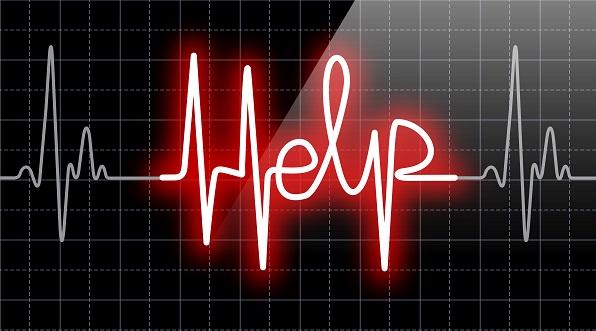SMART-MI: Implant IDs Large Burden of Arrhythmic Events Post-MI
These high-risk patients, based on two markers of autonomic dysfunction, would not be eligible for ICDs given their LVEF.

(UPDATED) Implantable cardiac monitoring (LINQ, Medtronic) is significantly better than usual care at identifying serious and prognostically relevant arrhythmic events in high-risk patients with autonomic dysfunction after myocardial infarction, according to the results of the SMART-MI trial.
The study, which was presented today during the opening Hot Line session at the European Society of Cardiology 2021 Congress, highlights the elevated risk for post-MI patients who don’t qualify for an implantable cardioverter-defibrillator (ICD) and suggests remote monitoring might be one way to keep close tabs on those at risk for sudden cardiac death, stroke, and other adverse outcomes stemming from post-MI arrhythmias.
“The majority of cardiovascular complications, including sudden death after myocardial infarction, occur in patients with ejection fractions above 35%,” said lead investigator Axel Bauer, MD (Innsbruck Medical University, Austria), during a press conference. “For these patients, no preventive strategies exist so far.”
Prophylactic ICD therapy is a class I indication for the post-MI patient with NYHA II or III heart failure and an LVEF < 35% at least 40 days out from the event. SMART-MI, on the other hand, included post-MI patients with only moderately reduced LVEF, defined as 36% to 50%, although patients were considered high risk based on two electrophysiologic markers of autonomic dysfunction. Carlos Aguiar, MD (Hospital Santa Cruz, Lisbon, Portugal), who chaired a press conference discussing the results, said SMART-MI gets to the crux of a problem faced by many cardiologists who manage higher-risk patients who have had an MI.
For these patients, no preventive strategies exist so far. Axel Bauer
“We see these patients and the LVEF is not depressed [enough] where you would have a clear, class I indication to go ahead with an ICD implantation,” he said. “But there are features of the patient or that [are seen] on imaging where they leave you concerned, where you sometimes think: ‘It would be great if this patient’s LVEF was really below 35%, because I’m not comfortable leaving this patient without an ICD.’”
High Arrhythmic Burden
SMART-MI was a prospective, open-label study conducted at 33 centers in Germany and Austria. Investigators screened 1,305 post-MI patients with moderately reduced LVEF, identifying 400 high-risk individuals with cardiac autonomic dysfunction as assessed by deceleration capacity (DC) and periodic repolarization dynamics (PRD), then randomized them to remote cardiac monitoring or conventional follow-up.
To TCTMD, Bauer explained that DC is an advanced marker of heart rate variability that assesses autonomic function at the level of the sinus node. Previous studies have shown that DC is a “robust marker of overall vagal function,” he said. In contrast, PRD captures low-frequency oscillations of cardiac repolarization instability believed to be caused by sympathetic activity. PRD, said Bauer, has been shown to be closely aligned with the presence of arrhythmia. Both DC and PRD are calculated via a biosignal analysis from the patient’s ECG and should be considered as complementary when used to sharpen risk stratification in post-MI patients, said Bauer.
During a median follow-up of 21 months, they detected 60 serious arrhythmic events in 201 patients randomized to implantable cardiac monitoring and 12 serious arrhythmic events in 199 patients treated with conventional follow-up (P < 0.0001). The serious arrhythmic events consisted of atrial fibrillation (≥ 6 minutes), nonsustained ventricular tachycardia, atrioventricular block ≥ IIb, and sustained ventricular tachycardia/ventricular fibrillation.
It would be great if this patient’s LVEF was really below 35%, because I’m not comfortable leaving this patient without an ICD. Carlos Aguiar
In terms of the clinical implications of the increased detection, the MACCE rate was similar in the implantable monitoring group and those followed conventionally (25 vs 26, respectively). In both groups, detection of a serious arrhythmic event was highly predictive of subsequent MACCE, with a positive predictive accuracy of roughly 60% in each study arm.
“This means that the prognostic impact of an arrhythmia does not depend on the mode of detection,” said Bauer. Sensitivity, however, was markedly better with implantable remote monitoring (60% vs 20%, respectively).
Would Preventive Measures Save Lives?
Speaking with the media, Bauer said the implantable cardiac monitor allows for continuous cardiac risk assessment in high-risk post-MI patients with autonomic dysfunction but only moderately reduced EF. The identification of serious arrhythmic events might open the door for preventive therapies to reduce the risk of sudden cardiac death or other outcomes, but Bauer stressed SMART-MI is a diagnostic study only and not powered for clinical outcomes.
When investigators detected a serious arrhythmic event, the local hospital treating the patient was informed within 48 hours, though how to manage the detected arrhythmia was left to the discretion of the physician. During the study, said Bauer, the number of additional diagnostic and therapeutic interventions was higher in patients randomized to the implantable cardiac monitor compared with the control arm. In total, 13 patients tracked with remote monitoring underwent ICD implantation, six had a pacemaker implanted, and 37 started oral anticoagulation after the identification of atrial fibrillation. In the control arm, the respective numbers were five, zero, and 11.
“We don’t know presently whether these preventive measures are really effective, but they were guideline-based,” Bauer told TCTMD. He is hopeful that future studies will investigate whether continuous telemetric risk assessment with this or other mobile devices can lead to better clinical outcomes. Such a trial would need roughly 2,600 patients to be able to detect a treatment effect of 25% between remote monitoring and usual care, he estimated.
Speaking during the Hot Line session, Carina Blomström-Lundqvist, MD, PhD (Institution of Medical Science, Uppsala, Sweden), said that implantable cardiac monitoring has been previously demonstrated to be sensitive, specific, and accurate for the detection of atrial fibrillation and ventricular tachycardia. For that reason, the higher rate of detection of serious arrhythmic events was “not surprising” with continuous monitoring.
“I think the main message is that serious subclinical arrhythmic events . . . was predictive of MACCE, so it was a good prediction tool for serious cardiovascular events,” said Blomström-Lundqvist. “Whether these findings can translate into a risk-prediction tool that can identify patients suitable for treatment to improve outcomes is unclear.” Like Bauer, she said that a larger study would be needed.
Gerhard Hindricks, MD, PhD (University of Leipzig, Germany), one of the session’s , said SMART-MI is an intriguing, hypothesis-generating trial, and praised the investigators for tackling a high-risk patient population where there is limited data on the best management strategy. He questioned the inclusion of atrial fibrillation as a serious arrhythmic event if the goal is to identify patients at high risk for sudden cardiac death.
“The question is whether atrial fibrillation is an appropriate endpoint,” said Hindricks. “Needless to say, we know that post-myocardial infarction patients that develop atrial fibrillation are at high risk for MACE, stroke, and heart failure, and for other complications.”
In response, Bauer said continuous monitoring in high-risk patients “is not only about sudden cardiac death.” Ten years ago, the cardiology community focused on the use of ICDs in select post-MI patients, but the “story is much more complicated and SMART-MI is a good example to show this,” said Bauer. “Patients are not only dying of sudden death, but they’re dying for various reasons.”
Similarly, Aguiar said he frequently encounters post-MI patients who are at risk of developing reentrant tachycardia, as an example, based on the extent of myocardial scarring on imaging, such as cardiac magnetic resonance (CMR). Unless the LVEF is < 35%, “you’re left with your concerns,” he said. He noted that a number of CMR studies have investigated whether the imaging modality can help stratify patients at high risk for arrhythmic events who don’t qualify for a prophylactic ICD. Whether it’s the use of markers of autonomic dysfunction or imaging-based modalities, he believes that risk stratification in the post-MI patient can still improve.
“There are a number of abstracts and papers showing that the acuity of predicting sudden cardiac death caused by arrhythmia using only the LVEF is rather poor,” said Aguiar. “There has to be considerable room for improving the risk prediction of sudden cardiac death, which is a spotlight theme this year at the Congress, and our capability to prevent it.”
SMART-MI, Aguiar added, emphasizes that the arrhythmic burden is significant in high-risk post-MI patients. François Schiele, MD (Université de Franche Comté, Besançon, France), who wasn’t involved in the study but commented on the results to the media, was also taken aback by the number of serious arrhythmic events picked up by remote cardiac monitoring, which he said he wouldn’t have expected given the baseline LVEF.
Bauer emphasized that even though there are other markers of autonomic dysfunction, such as heart rate variability, and imaging studies have identified high-risk post-MI patients, the point is that continuous monitoring can be used to stratify patient risk further.
“Continuous risk assessment, that’s of key importance here,” said Bauer. “If, in the course after myocardial infarction, the patient develops some signs of arrhythmia, then he jumps to another risk level and needs much better follow-up. How this follow-up looks, I don’t know, but ICD implantation is not the only solution definitely.”
Michael O’Riordan is the Managing Editor for TCTMD. He completed his undergraduate degrees at Queen’s University in Kingston, ON, and…
Read Full BioSources
Bauer A, et al. Implantable cardiac monitors in high-risk post-infarction patients with cardiac autonomic dysfunction and moderately reduced left ventricular ejection fraction. Presented at: ESC 2021. August 27, 2021.
Disclosures
- SMART-MI was funded by the German Center for Cardiovascular Research and the Medtronic Bakken Research Center.
- Bauer, Aguiar, Schiele report no relevant conflicts of interest.





Comments